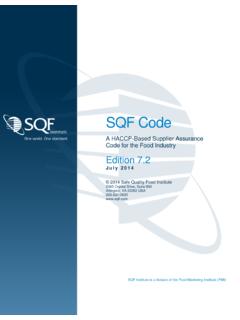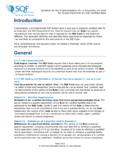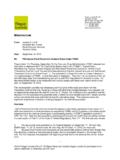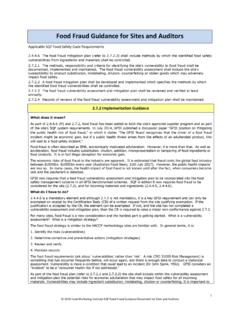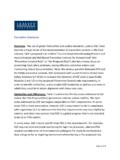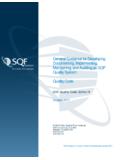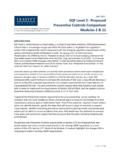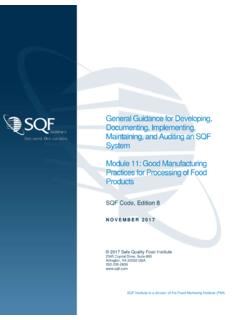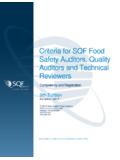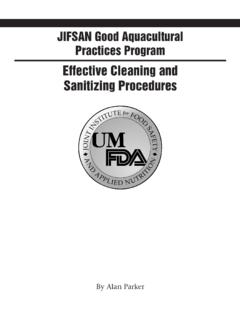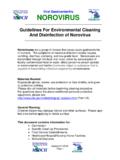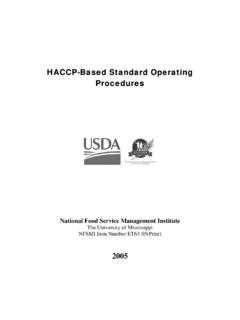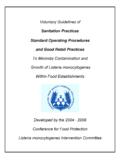Transcription of SQFI Guidance RE: 2.8.3 Allergen Cleaning and …
1 SQFI Guidance RE: Allergen Cleaning and sanitation practices 1 October 25, 2012 1. INTRODUCTION The SQF Institute provides updates to expand on the meaning of the SQF Code, and provide further Guidance on the important issues addressed in the SQF Code. The management of allergens is covered in the 7th Edition of the SQF Code in Module 2, section In this update, SQFI addresses Allergen management, with particular emphasis on Cleaning and sanitation practices for Allergen control. Food allergies affect a small but growing proportion of the population. They are most common in children, although some can be life-long, and can cause mild to severe and sometimes life-threatening reactions. Most food allergens are proteins and are not denatured in the food manufacturing process. Their recognition, management and communication to the consumer are therefore extremely important.
2 Allergens in food can be intentional ( nuts in nut based products, milk in milk-based products), or cross-contact , which is the term used when a residue or trace amount of an allergenic ingredient is unintentionally added to a food product. This can happen due to ingredient mixing, line change-overs, or insufficient Cleaning and sanitation procedures . The responsibility and methods used to control allergens and to prevent sources of allergens from contaminating product shall be documented and implemented. Document the responsibility and methods used to control allergens and prevent cross contact with any dissimilar allergenic or non- Allergen containing materials Some food products contain ingredients that are known allergens and must be declared and labeled according to the regulatory labeling requirements in the country of origin and country of destination. However cross-contact allergens are more difficult to control.
3 These are trace or occasional allergens that are not intended to be in the product and will not appear on the ingredient listing. They occur through incorrect formulation, poor line scheduling, rework, processing aids, or unexpected presence in ingredients (eg lactose used as a carrier for flavors). Cross contact allergens can only be controlled through thorough and effective management practices within the plant. (Note: many retailers will not accept may contain labeling as a management control on retailer-branded products. Intentional inclusion of allergenic ingredients must be properly labeled. However cross-contact allergens must be prevented by means of proper management controls) The Allergen management program shall include a risk analysis of those raw materials, ingredients and processing aids, including food grade lubricants that contain allergens A documented risk (hazard) analysis of all the ingredients, raw materials and processing aids that are used in the facility shall be conducted.
4 Each facility must know the intentional and cross-contact allergens that could occur, and the potential risk of occurrence. This includes ensuring suppliers of materials, ingredients, and processing aids (including food-grade lubricants) declare any allergenic substances in the materials they are supplying, including the potential for cross contact allergens. This not only applies to ingredients used in a particular finished product, but those used throughout the facility. The risk assessment must also apply to potential allergens in materials and products that are stored or produced on other lines in the same facility, or at other times on SQFI Guidance RE: Allergen Cleaning and sanitation practices 2 October 25, 2012 the same line. For example a confectionery manufacturer may produce a number of product lines, but only one contains peanuts.
5 The risk assessment must include the potential for peanut allergens to contaminate non-peanut products. The Allergen management program shall include a register of allergens which is applicable in the country of manufacturer and the country(ies) of destination A register (list) of allergens in the facility that are of concern in the country of manufacture and the country of sale shall be developed. The list of regulatory allergens varies from country to country, and food manufacturers must be familiar with the declarable allergens in the countries in which the products are sold, and ensure that the labeling laws in that country are met. They must also be aware of changes in legislation, as regulatory allergens change from time to time. The Allergen management program shall include a list of allergens which is accessible by relevant staff A list of everything in the processing facility that contains allergens that can be accessed by the staff involved in production operations shall be outlined.
6 Staff awareness is critical to avoiding unintentional inclusion of trace amounts of allergenic material in products, and training must be provided that includes the consequences of unintentional consumption of allergens and the methods required to prevent contamination. Trace amounts of allergenic materials can be transferred to products from clothes, incorrect ingredient selection, spillages, and inadequate Cleaning The Allergen management program shall include the hazards associated with allergens and their control incorporated into the food safety plan. The food safety plan must show the hazards (potential problems) associated with storage, movement, and use of allergens in the plant and how those hazards are controlled All identified intentional and cross contact allergens must be included in the HACCP Food Safety Plan, and their controls identified.
7 In some instances, Allergen controls may be identified as CCPs due to the risk to public health, infringement of labeling regulations, and the potential for product recall. (Many recalls have occurred due to non-declaration of allergens) Controls may include, but are not limited to: Specifications for ingredients and raw materials; Receipt and separate storage of raw materials and ingredients; Separate storage of work-in-progress, and finished products; Scheduling of Allergen containing materials after non- Allergen containing materials Equipment design to avoid build-ups, bottle necks, and to allow for separation of highly allergenic materials Control of rework; Allergen Cleaning and sanitation procedures (refer below) Testing of products and equipment SQFI Guidance RE: Allergen Cleaning and sanitation practices 3 October 25, 2012 The Allergen management program shall include instructions on how to identify, handle, store and segregate raw materials containing allergens provided to staff responsible for receiving those target raw materials.
8 The Allergen management program shall include provision to clearly identify and segregate foods that contain allergens Instructions for the receiving and operational staff on how to identify, store, and keep separate non-allergenic materials and any materials known to contain allergens shall be documented. SQF suppliers must identify all allergenic ingredients at receipt, and store them separately from non-allergenic materials, and from materials containing other types of allergens. Staff involved in receiving and storage must be fully aware of the presence and risk of allergens and the storage procedure. All ingredients must be clearly labeled with the name of the allergenic substance, and must be stored and transported to avoid spillage or leakage onto other non-allergenic materials. Cleaning and sanitation of product contact surfaces between line changeovers shall be effective, appropriate to the risk and legal requirements, and sufficient to remove all potential target allergens from product contact surfaces, including aerosols as appropriate to prevent cross contact.
9 Based on risk assessment, procedures for validation and verification of the effectiveness of the Cleaning and sanitation of areas and equipment in which allergens are used shall be effectively implemented. Cleaning and sanitation procedures on lines producing allergenic and non-allergenic products must be effective and validated. Effectively documented, implemented and validated Cleaning procedures are essential to avoid cross contact allergens transferring across products. This is discussed in greater detail in section 2. Separate handling and production equipment where satisfactory line hygiene and clean-up or segregation is not possible. Where satisfactory Cleaning cannot be implemented, separate handling and production equipment is required. Where the Allergen risk is greater (eg peanut protein can cause serious allergic reactions in minute trace quantities), or the processing equipment design does not permit adequate Cleaning , separate and isolated production equipment must be provided to avoid cross contact.
10 Care must also be taken to avoid cross contact due to air flow, transfer on tools or equipment, or staff movement from one line to the other. 2. Cleaning VALIDATION AND VERIFICATION One of the areas of possible confusion is the requirements for Allergen Cleaning validation and verification. Section states; Cleaning and sanitation of product contact surfaces between line changeovers shall be effective, appropriate to the risk and legal requirements, and sufficient to remove all potential target allergens from product contact surfaces, including aerosols as appropriate, to prevent cross contact. SQFI Guidance RE: Allergen Cleaning and sanitation practices 4 October 25, 2012 Section states Based on risk assessment, procedures for validation and verification of the effectiveness of the Cleaning and sanitizing of areas and equipment in which allergens are used shall be effectively implemented.
